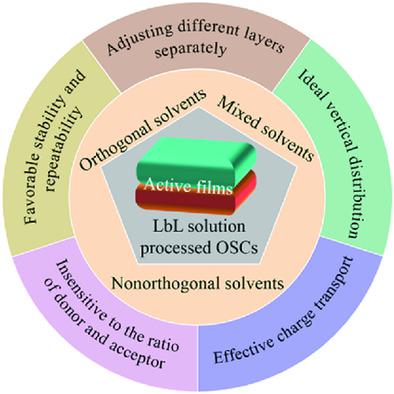Our official English website, www.x-mol.net, welcomes your feedback! (Note: you will need to create a separate account there.)
Layer‐by‐Layer Solution Processing Method for Organic Solar Cells
Solar RRL ( IF 7.9 ) Pub Date : 2020-11-10 , DOI: 10.1002/solr.202000592 Xinrui Li 1 , Xiaoyang Du 1 , Juewen Zhao 1 , Hui Lin 1 , Caijun Zheng 1 , Silu Tao 1
Solar RRL ( IF 7.9 ) Pub Date : 2020-11-10 , DOI: 10.1002/solr.202000592 Xinrui Li 1 , Xiaoyang Du 1 , Juewen Zhao 1 , Hui Lin 1 , Caijun Zheng 1 , Silu Tao 1
Affiliation

|
Organic solar cells (OSCs) have attracted wide attention due to their economy, environmental protection, and potential for large‐scale commercial production. The layer‐by‐layer (LbL) solution processing method, where donor solution and acceptor solution are coated sequentially, is a simple and effective way to fabricate OSCs, achieving a high power conversion efficiency (PCE) of up to 17%. Compared with bulk‐heterojunction (BHJ) OSCs, LbL solution‐processed OSCs separately adjust different layers, making the components distribute ideally in the vertical direction that is beneficial for exciton dissociation, charge transport, and charge collection. Moreover, the LbL approach has better potential in the preparation of large‐area devices, which is a key link in the commercialization of OSCs. Herein, the basic principles and the latest research progress of LbL solution‐processed OSCs are summarized, and the existing challenges and prospects of the LbL solution processing method in industrial production are discussed.
中文翻译:

有机太阳能电池的逐层溶液处理方法
有机太阳能电池(OSC)由于其经济,环保和具有大规模商业生产的潜力而受到广泛关注。依次涂覆施主溶液和受主溶液的逐层(LbL)溶液处理方法是一种简单有效的制造OSC的方法,可实现高达17%的高功率转换效率(PCE)。与本体异质结(BHJ)OSC相比,LbL溶液处理的OSC分别调整不同的层,使组件在垂直方向上分布理想,这有利于激子离解,电荷传输和电荷收集。此外,LbL方法在准备大面积设备方面具有更大的潜力,这是OSC商业化的关键环节。在这里
更新日期:2021-01-07
中文翻译:

有机太阳能电池的逐层溶液处理方法
有机太阳能电池(OSC)由于其经济,环保和具有大规模商业生产的潜力而受到广泛关注。依次涂覆施主溶液和受主溶液的逐层(LbL)溶液处理方法是一种简单有效的制造OSC的方法,可实现高达17%的高功率转换效率(PCE)。与本体异质结(BHJ)OSC相比,LbL溶液处理的OSC分别调整不同的层,使组件在垂直方向上分布理想,这有利于激子离解,电荷传输和电荷收集。此外,LbL方法在准备大面积设备方面具有更大的潜力,这是OSC商业化的关键环节。在这里



























 京公网安备 11010802027423号
京公网安备 11010802027423号